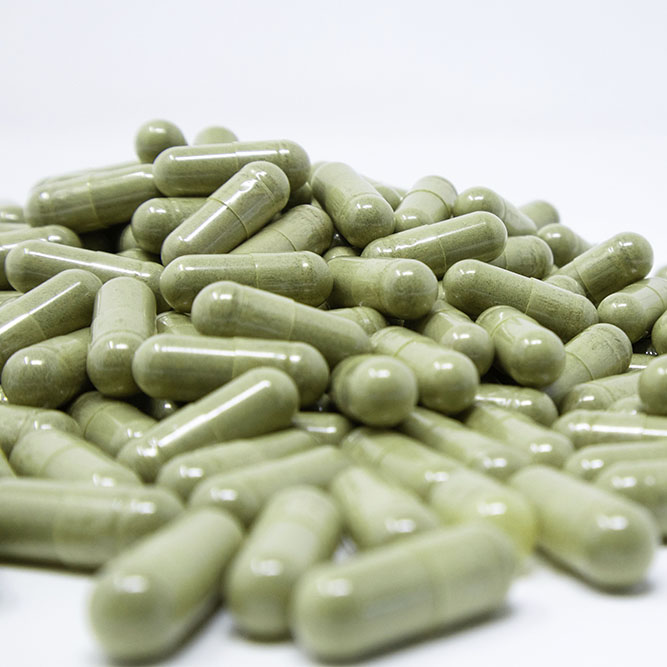The leaves of Mitragyna speciosa, commonly known as kratom, are used for a range of purported benefits. There are many methods of taking kratom that allow the user to meet their needs or create their own individual experience with the botanical. One of the most common ways to take kratom is in capsule form.
What Are Kratom Capsules?
Kratom capsules are typically small capsules that contain kratom leaves that have been crushed or ground into kratom powder. However, capsules may also be produced that instead contain a liquid kratom extract. Capsules filled with this liquid kratom concentrate are typically smaller as the kratom they contain is more potent.
Kratom Capsules vs Pills
Capsules are shaped like pills, though they are not typically pressed into an actual pill or tablet. The capsule houses the kratom powder and can be filled to different measurements or doses. Capsules differ from pills in a few distinct ways:
- Kratom capsules act as a shell that holds a pre-measured dose
- Because the capsule holds the kratom dose, the kratom does not need to be mixed with a binding agent to create a pill, keeping the kratom pure from extra ingredients
- Capsules are often made from gelatin or collagen from an animal or plant and break down quickly after consumption, making the benefits of kratom more quickly available to the body
- Capsules generally do not have a flavor or taste associated with their use
What Kratom Strains Are Used In Kratom Capsules?
Though all kratom comes from a single species, there are different strains that offer different effects or speeds. A kratom strain describes both the vein color, and the region where the kratom was sourced.
The primary kratom vein types include:
The primary sources and countries of origin for kratom include:
- Bali
- Sumatra
- Thai
- Borneo
- Malayasian
- Sudanese
Capsules may contain only a single strain of kratom, or the user may mix strains to blend specific benefits or effects. Additionally, kratom may come in Maeng Da strains, which is a way of saying the kratom is prime or top-shelf. Maeng Da kratom comes in the same strains as indicated above, but is supposed to be a more premium and potent version of the strain. Maeng Da kratom strains can typically be purchased in capsules.
How to Take Kratom Capsules
Kratom capsules provide the simplest method of kratom consumption. Capsules come in standard sizes, so they require no further measurement when loading, or in combination with any other food or beverage for consumption. If you choose to take kratom in capsule form, it is important to understand capsule sizing and kratom dosage, especially if you plan to take it for long-term benefit.
How Many Kratom Capsules Should I Take?
Managing your dosage through capsules may depend on a few things. Because capsules sizes may vary, it is important to read any labels and check with your distributor to see what size the capsules are, and what grams or doses they contain. Common sizes and their corresponding volume include:
- Capsule size: 000. Volume capacity: 1.3ml
- Capsules ize: 00E. Volume capacity: 1ml
- Capsule size: 00. Volume capacity: 0.9ml
- Capsule size: 0E. Volume capacity: 0.78ml
- Capsule size: 0. Volume capacity: 0.68ml
- Capsule size: 1. Volume capacity: 0.48ml
- Capsule size: 2. Volume capacity: 0.36ml
- Capsule size: 3. Volume capacity: 0.27ml
- Capsule size: 4. Volume capacity: 0.20ml
- Capsule size: 5. Volume capacity: 0.13ml
Typically 1ml = 1gram. For example: If you typically consume one gram of kratom for your chosen dose, you might take:
- One size-00E capsule
- Or, four individual size-4 capsules
If your regular dosage was two grams, you might take:
- Two size-00E capsules
- Or, eight size-4 capsules
Again, this is just a general guide to common sizes; always check with your kratom retailer for more precise information about capsule size and kratom dosage.
Pros and Cons of Kratom Capsules
When deciding which method of consumption is best, it can be helpful to analyze the pros and cons of each method. When taking kratom in capsule form there are a few benefits and drawbacks that will be discussed below.
Pros
The pros of taking kratom capsules for your daily dosage may include:
-
- Ease of dosage. Kratom purchased in capsule form typically has an exact and predetermined dosage. This makes measuring and consuming your preferred dose much easier than trying to weigh out or prep other forms of kratom such as whole leaf, powder, or extracts
- Capsules are discreet and easy to carry. Capsules are small, portable, and convenient. The powder form of kratom is contained in the capsule shell, making your dose of kratom easy and clean to transport. Taking kratom in capsule form is also a simple and discreet method of dosing that can be done anywhere
- Kratom capsules have little taste. Kratom is known for its bitter botanical flavor, a taste that is not preferred by some users. While there are some methods of consumption that attempt to mask the flavor by adding sweeteners to tea, or by integrating powder into other food and drink, capsules are generally easy to swallow and are only mildly flavored by the capsule type
- The potency of kratom capsules is stable. Many forms of ingesting kratom require some form of heat application — from brewing tea, to smoking kratom leaves, or by baking or cooking the kratom with food. Studies on the stability of alkaloids present in kratom show that pH and temperature may impact degradation of the prominent alkaloids such as mitragynine, 7-hydroxymitragynine, speciocilatine, speciogyniny, and paynantheine, though further study of the reactions of these alkaloids to their environment is needed
Cons
The cons of taking kratom capsules for your daily dosage may include:
- Capsule allergy or dietary aversions. Most standard capsules are made of easily digestible biodegradable material from plant or animal collagen or cellulose, making some capsules vegetarian or nonvegetarian. Some may also experience allergic reactions to the inactive ingredients such as gelatin or seaweed used in capsule production
- Capsules may be more expensive. Because of the additional processing included in making capsules; costs to purchase the capsules, time and manufacturing in measuring, filling, and packing, purchasing kratom in capsule form may be more expensive than purchasing bulk kratom powder
How to Make Your Own Kratom Capsules
If you are interested in taking kratom in capsule form, but would like to create your own strain mixture or dosage potency, you may choose to make DIY kratom capsules. To make your own herbal or kratom capsules you may need a few tools and a little insight into the process.
- Select a capsule size that is appropriate to your preferred dosage and fill each capsule. This should provide you with the proper dosage amount per capsule
- You may also use a digital scale to measure the total amount of kratom used to fill each capsule
- A few additional accessories may include a capsule tray to help with manually filling, and/or a spoon and funnel to make handling your ingredients easier
- When you have equally filled all of the capsules, divide the total amount of capsule by the total amount of kratom powder to discover the dosage of each capsule
Kratom capsules are a common, popular method for purchasing and consuming kratom. It allows for a fast, simple way to monitor and control dosage, and most strains of kratom are available in capsule form. More experienced users may even purchase kratom powder or extract and fill their own capsules, though this requires precision and caution in order to guarantee a consistent dosage per capsule. If you are newer to kratom, capsules may provide a more accessible way to learn more about the right dosage and benefits of taking kratom.






